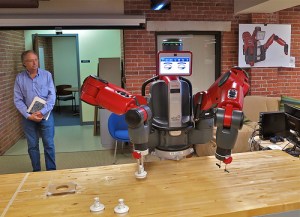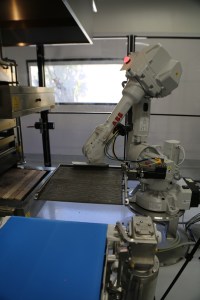For Americans struggling with stagnant wages, under- or un-employment, one of Donald Trump’s most appealing campaign promises was to bring manufacturing jobs back to the U.S.
Navigating the complexities of policy, tariffs and geopolitics would make that hard enough already for the president elect. But technology will make this promise nearly impossible to fulfill.
Why? Because manufacturing jobs are increasingly done by robots, not people.
Robotics have already helped reduce reliance on labor overseas for manufacturers in automotive, electrical and electronics industries, according to a fresh policy report from the United Nations Conference on Trade & Development.
And automation does allow manufacturers to do business in the U.S. when they may have chosen to do it in Southeast Asia or somewhere else, before.

Rethink Robotics’ Baxter.
But when manufacturing returns to the states, jobs aren’t coming with it in high numbers. Automation has left workers in developing nations without employment, the report notes, and the U.S. faces the same prospect.
Startups creating interesting robotics that stand to “steal” jobs from people, either here or abroad, are attracting seed and venture funding.
Players in this space include burger flipping and pizza making robots, respectively, from Momentum Machines and Zume, painting robots from Rational Robotics. Then there are the likes of Modbot and Baxter, robots configurable for a wide range of purposes in manufacturing and elsewhere.
It’s not just startups, though. Large brands like Nike and Adidas have shed contractors and embraced robotics and 3-D printing to make their shoes. Large farms have long employed robots in the field, and major companies like Amazon and UPS rely heavily on robots for logistics and warehousing.

Zume’s pizza-making robots.
UNCTAD’s report explained, “increased use of robots in developed countries erodes traditional labor-cost advantage of developing countries,” and is already having a global impact.
It’s not just that robots ramp up productivity. They can help companies streamline all kinds of headaches affiliated with setting up shop overseas.
A manufacturer outsourcing to vendors or hiring employees across borders will have to deal with the costs of managing people, design, quality, safety, customs and logistics, regulatory compliance and intellectual property from afar.
“Reshoring” becomes more appealing with every technological advance in robots, since it reduces administrative and legal overhead as well as labor costs.
And robots aren’t getting dumber, obviously. Advances in computer vision and artificial intelligence promise to make robots, and the software-brains inside of them, even more competitive with people, especially in manufacturing but even in physical security or hospitality.
Yes, robot cashiers, assistants, security guards and flight attendants are a thing.
Let’s just hope there’s always a market for “handmade” goods and human-delivered services, and perhaps a robot that can help teach former employees new work skills.
